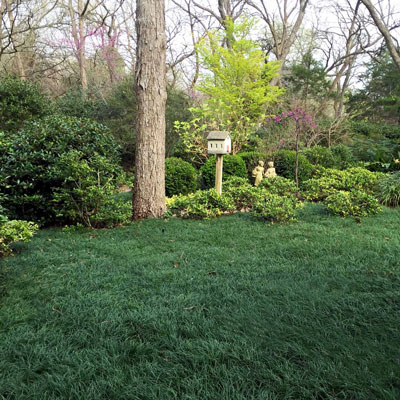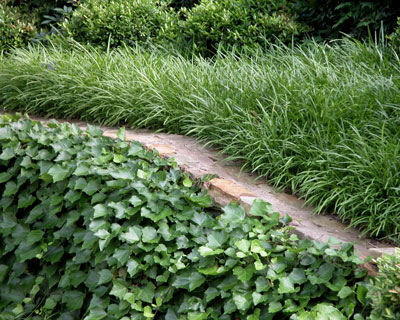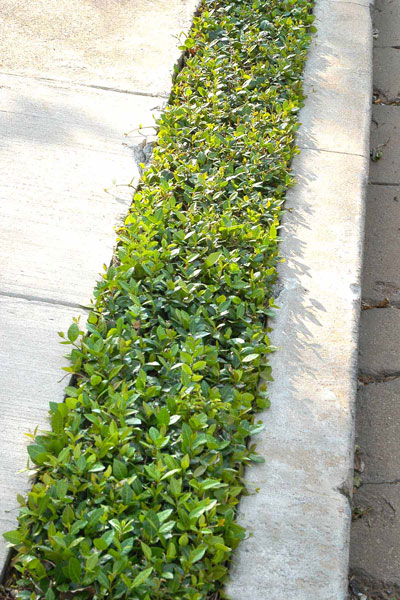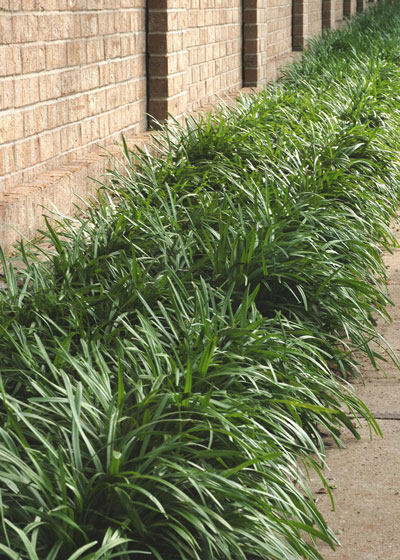How Great Are Groundcovers?

Not only is this area of the Sperry landscape heavily shaded, but it’s also on an incline steep enough that erosion would have been a concern. Regular mondograss propagated from other beds in our landscape covered quickly.
It’s not exactly the question I’ve heard most often in the past week, but every time that I do hear it, my nerves start to shake:
“Neil. I’m tired of all the care I have to give my lawn. I’d like a groundcover I could plant and basically forget. I’d never have to mow it again. What do you think?”
I get this question frequently. Never often enough to call it my “Question of the Week,” but often enough that I want to reach out to spread the true facts. (Sounds like a sermon may follow.)
People who ask me that question often seem to be setting themselves up for disappointment. The lowest maintenance groundcover, unless there are extenuating circumstances, will always be turfgrass. Mowing and trimming (with machines, not on your hands and knees) and weed control (herbicides versus pulling by hand) make for compelling arguments.
It’s hard to imagine a landscape without at least a few beds of groundcovers. They’re the natural transition from shrubs to lawngrass – a manageable step in mature height. So almost every garden has the perfect spot for one or two groundcovers.

Dwarf mondograss on right fills small voids in Sperry landscape. Lamium on left sprawls over a larger area. They transition up to the smaller shrubs that you see.
However, groundcovers require a lot more manual labor and nurturing. You have to plant them by hand. You may even want to water them by hand for a short while to be sure they’re established. You trim them somewhat by hand, and you probably won’t run a wheeled fertilizer spreader through them, so there’s some measure of hand labor in trimming. And weeds – oh, we mustn’t forget our weeds. You get to pull them by hand. There will be many until the groundcover gets established and dense. After that, unless you let bermuda creep into the bed, you’re probably good to go.
When Groundcovers Are Definitely Easier
All of that said, there are three times when groundcovers will definitely be easier than turfgrass. Most of us have one or two. Many of us have all three.
• Ground is too steep to mow. Older neighborhoods were often built a couple of feet above city streets. Homeowners were left with that uncomfortable slope and no safe way to mow it. Groundcovers that form dense clumps or that spread assertively to cover the soil are both outstanding options. My choices for most of Texas: mondograss in the shade and purple wintercreeper euonymus or Asian jasmine in sun. (Asian jasmine is winter hardy in much of Zone 7, but be careful if your area routinely drops below 10F.)

English ivy holds soil on a very steep slope, while liriope breaks rush of water off surface above.
• Bed is too long and narrow to edge. This is probably a place for mondograss or liriope if it’s in shade, or at least if it receives no hot, direct sun after mid-morning. I’ve used wintercreeper in such a spot, even in full sun, but you have to keep it from climbing up the side of the house and you’ll have to trim to control its height or spread. If you have full or nearly full sun, you might even make a case for one of the hybrid bermudas mowed and trimmed impeccably. It would be extra work, but it would be very handsome.

Asian jasmine must be trimmed, but it makes a cheerful low cover between pieces of concrete.

Liriope adds grace and greenery to a planting space that would be almost impossible to fill otherwise.
• There is too much shade to grow turfgrass. If your trees have grown to the point that their shade is preventing grass from growing, and if you’ve tried removing one or two lower branches to get more sun onto the lawn early or late in the day…. If you’ve tried all that, and the ground is still bare, it’s time for mondograss, liriope, wood ferns, purple wintercreeper, English ivy, Asian jasmine, and in warmer South Texas, ardisia and aspidistra. That’s a collection of widely varied types of shade-tolerant groundcovers, and there are dozens more. Let your nurseryman show you the options before you waste still more money trying new sod.
